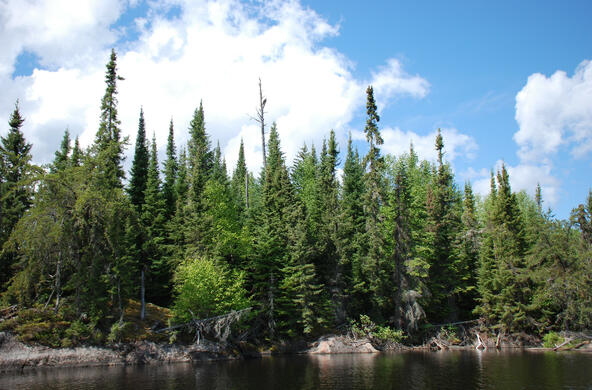For more than half a century, scientists have converged on the Hubbard Brook Experimental Forest in the White Mountains of New Hampshire to explore how forest ecosystems work, from the flow of water and nutrients to the ecology and behavior of forest animals. HUBBARD BROOK: The Story of a Forest Ecosystem captures the rich history of research at the site, including how it has transformed environmental policy, resource management, and forestry practices – locally, regionally, and nationally.
Ecologists Richard T. Holmes of Dartmouth College and Gene E. Likens of the Cary Institute of Ecosystem Studies coauthored the book. Longtime members of the Hubbard Brook research community, they provide an insider’s view of this unique forest-turned-laboratory. Readers will discover the natural history of the site, the guiding role of the watershed-ecosystem concept, long-term studies of disturbance (natural and human made), the role of animals in ecosystem processes, and challenges for the future.

Hubbard Brook is best known for being the site where Likens and colleagues first discovered acid rain in North America, and the home of pioneering studies that have advanced our understanding of how acid rain and other atmospheric pollutants impact forests and adjacent freshwaters. This work has informed a range of policy measures, including the 1990 Amendments to the Clean Air Act.
Another distinguishing feature of Hubbard Brook research has been the experimental manipulations of whole watersheds, which have revealed how environmental stresses ripple through the forest ecosystem, influencing everything from soil fertility and the growth of trees to the survival of animals and the quality of water delivered downstream. Other notable findings from the 50 years of inquiry include the ecological effects of clear-cutting and other forestry practices, causes of population change in forest birds and mammals, and how pests, pathogens, extreme weather, and climate change affect forests and nearby streams and lakes.
Likens comments, “The most enduring lesson we can learn from Hubbard Brook is the critical role that sustained, place-based ecological studies play in diagnosing environmental problems and setting and assessing management and policy solutions. We are much more effective stewards when we have long-term monitoring to guide us, but the reality is that such studies are quite rare.”
The Hubbard Brook Experimental Forest was established by the U.S. Forest Service to explore the relationship between forests and New England’s water supply. In 1963, while a professor at Dartmouth, Likens and faculty colleagues F. Herbert Bormann and Noye M. Johnson partnered with U.S. Forest Service scientist Robert S. Pierce to initiate the Hubbard Brook Ecosystem Study, broadening research at the site to include ecology, hydrology, and biogeochemistry. In 1969, Holmes and his colleagues began studies of birds and other animals living in the forest, thus widening the scope of the project even further.
Hubbard Brook has inspired collaborations among federal agencies and academic scientists. Research has resulted in more than 1,500 peer-reviewed publications exploring everything from ice storms and air pollution to the impact of reduced snow cover on forest soils. Today, 50 investigators from more than 20 institutions conduct research at Hubbard Brook, making it one of the longest running and most comprehensive ecosystem investigations in the world.
Offered by Yale University Press, HUBBARD BROOK: The Story of a Forest Ecosystem provides an accessible review and synthesis of how researchers have used a living forest as an experimental laboratory. In the beautifully illustrated 270-page volume, Holmes and Likens showcase the role that long-term, collaborative ecological studies play in informing the protection of air and water resources, sustainable forestry practices, and wildlife conservation.
Holmes is a research professor of biology at Dartmouth College in Hanover, NH. He is also the Ronald and Deborah Harris Professor of Environmental Biology emeritus at Dartmouth. Likens is founder and president emeritus of the Cary Institute of Ecosystem Studies in Millbrook, NY. He is also Distinguished Research Professor at the University of Connecticut.
Praise for HUBBARD BROOK: The Story of a Forest Ecosystem
“A classic volume that brings a captivating story of scientific research with great policy implications up to date and challenges us to envision the future of this and all forest ecosystems.”—David Foster, author of Hemlock
“The authors have elegantly packaged a 50-year history of the Hubbard Brook project into a very readable book that will be of interest to a wide variety of disciplines.”—James Galloway, University of Virginia
“A tremendous accomplishment. The work is original and the scholarship is excellent. It is extremely important and it absolutely will be a cherished book.”—Andrew Friedland, Dartmouth College
“An essential addition to the bookshelves of professional ecologists, natural history buffs, and New England armchair ecologists.”—Meg Lowman, California Academy of Sciences
“This beautifully illustrated and wonderfully written book presents a comprehensive summary of 50 years of research at Hubbard Brook, perhaps the most iconic and influential long-term ecological research program ever conducted.”—Scott L. Collins, University of New Mexico
“Many important lessons have been learned in this fabled forest laboratory. By telling the Hubbard Brook story, Holmes and Likens give a gift to all who treasure the northern hardwood forest.”—Stephen Long, author of Thirty-Eight.
The Cary Institute of Ecosystem Studies is an independent, nonprofit environmental research organization located on 2,000 acres in New York’s Hudson Valley. A world-premier center for ecosystem science, areas of expertise include disease ecology, forest and freshwater health, climate change, urban ecology, and invasive species. Since 1983, our scientists have produced the unbiased research needed to inform effective management and policy decisions. Our science program is complemented by education and outreach initiatives.





